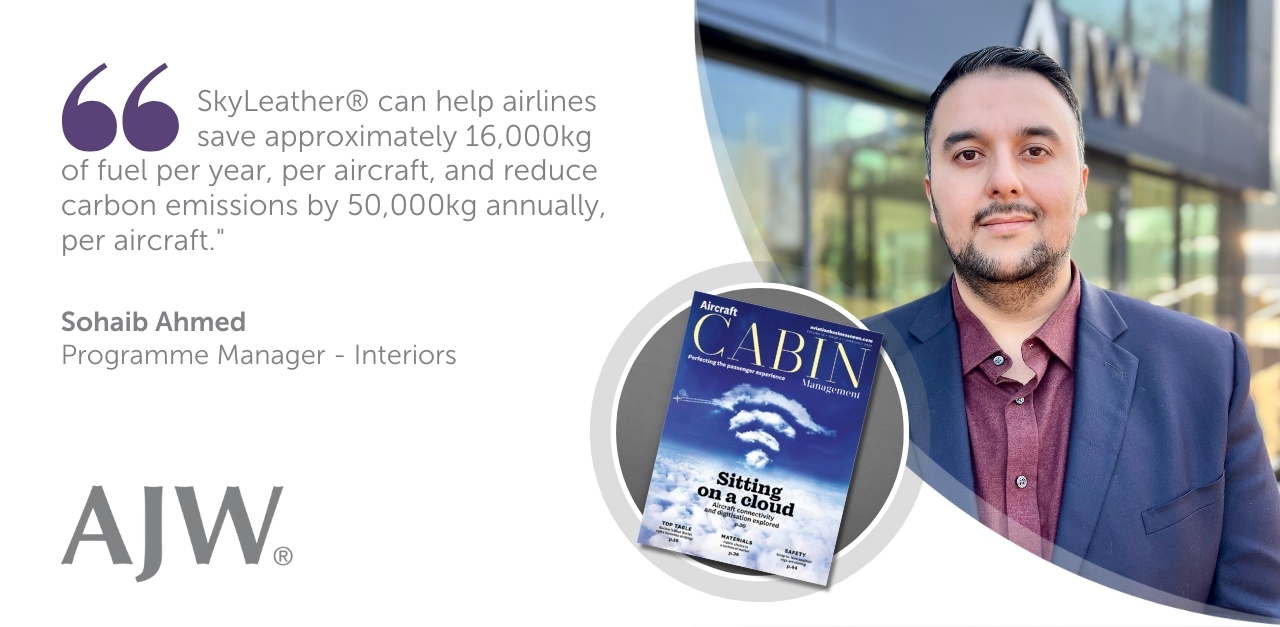

24/7 AOG Critical Response
Hotline![]() UK +44 1403 798888US +1 877 780 2008
UK +44 1403 798888US +1 877 780 2008
Our award winning global AOG service is manned 24 hours a day, 365 days a year.
Please call +44 1403 798888 or email aog@ajw-group.com.

6 Jul 2023

The aerospace industry is known for being highly regulated. From seats to sidewalls, all materials used onboard the aircraft must meet the requirements of the various controlling bodies across the globe.
The challenge, however, is for airline industry suppliers to meet the needs and demands of both the operator and the passenger.
In the latest issue of Aircraft Cabin Management, Bernie Baldwin speaks to industry experts on interior materials, who discuss how advancement in technology is changing the face of aircraft interiors and the passenger experience.
Baldwin discusses the difficulty in finding a balance between passenger comfort and the operator’s need for durability, lightness, and meeting industry standards for safety. Airlines are constantly striving to find ways to reduce aircraft weight, and in recent years, it is the redesign of economy seats that have been most effective in achieving this.
AJW Group Interiors Programme Manager, Sohaib Ahmed, believes research into material modifications will bring effective solutions to the fore. AJW’s partnership with Autostop Aviation, the largest seat cover manufacturing facility in Europe, has presented the industry with SkyLeather® a smarter seat covering and material of choice for airlines.
AJW Interiors’ SkyLeather®, is manufactured using 100 per cent water-based polyurethane and is known for its exceptional lightweight properties, says Ahmed. This environmentally friendlier product offers a weight saving of 25 per cent when compared with natural leathers, he continues, resulting in approximately 0.96kg saved per passenger. He states,
‘Based on the A320 and 737 aircraft families, implementing SkyLeather® can help airlines save approximately 16,000kg of fuel per year, per aircraft, and reduce carbon emissions by 50,000kg annually, per aircraft.’
Baldwin speaks with Ultrafabrics’ VP of Marketing and Branding, Barry Silverman, who reinforces Ahmed’s belief in modern materials being the way forward to reduce weight. Silverman explains the composition of Ultrafabrics’ product, Atago, and how the company has reduced the weight of its seat covering material to benefit operators.
Delving into advances in material research for more sustainable materials, Baldwin asks AJW’s Ahmed about the ease of cleaning and durability of SkyLeather®.
‘SkyLeather boasts effortless maintainability, as stains and marks can be easily wiped away using a cloth and soapy water,’ he explains, ‘In terms of durability, this revolutionary material surpasses expectations.’

Ahmed describes the successful and continued durability testing employing Wyzenbeek cycles. He states that AJW’s revolutionary ‘SkyLeather outperforms similar materials currently available on the market,’ and the company’s recent endorsement by Azerbaijan Airlines is a testament to this. The airline recently announced that it will be installing SkyLeather® on three of its A319 and six of its A320 aircraft.
Moving away from seat design and covering, the article discusses the progress being made in interior products, such as carpeting, panelling, and monuments. By utilising more lightweight products, manufacturers can assist with further weight savings for airlines. Combining the attributes of comfort, quality, and maintainability, interior products become not only more cost effective for operators but give passengers a better flying experience.
Ahmed discusses how weight reductions and environmental awareness are also finding their way into the development of innovative fibres and new light weight panel compounds used for the manufacture of galley storage units, and lavatories.
The consensus among industry stakeholders is that passengers enjoy a pleasant travelling environment, while airlines enjoy weight and cost reductions. The article concludes with sentiments from Sohaib Ahmed of AJW Technique Interiors,
‘In response to the threat of climate change, the aviation industry is committed to taking active measures toward the reduction of global greenhouse gas emissions. Businesses across the globe are working to reduce their carbon footprint and are investing in technology to design and develop more sustainable products to achieve this.’